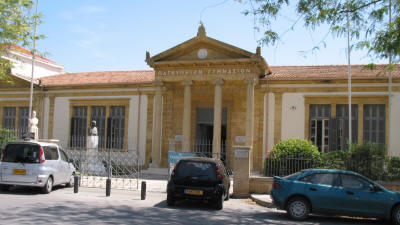Pancyprian Gymnasium (Severios Library)
Nicosia, South Cyprus
 |
| Pancyprian Gymnasium |
The Pancyprian Gymnasium is the oldest educational institution in Cyprus and was founded in 1812 by Archbishop Kyprianos, who also donated a small collection of theological books, editions of ancient Greek writers and a number of manuscripts, in order to establish a library for the school. It was originally called the Greek School, or Hellenic School.
In 1814, Greek nationalists on the mainland formed a secret organization called the Friendly Society (Filiki Eteria). With the support of wealthy Greek exile communities in Britain and the United States, the aid of sympathizers in Western Europe and covert assistance from Russia, they planned a rebellion in order to gain independence from the Ottomans. The Archbishop, who was prominent in this organisation, used the crypt in the basement of the school to conduct meetings of with other Cypriot members of Filiki Eteria.
In 1821, the Archbishop and his co-conspirators were executed for treason, and the school's functioning was suspended.
In 1830, the school reopened, and by 1893 it had developed into a six-grade secondary school. It was recognised by the Greek government as equivalent to Secondary Schools in Greece. In 1896, it was named The Pancyprian Gymnasium, a name which it retains to this day.
The original library burned down in 1920 and a great number of books were destroyed. The library was then transferred into a wing of he school building, which now houses the teachers' room.
In 1921, a new building was built to replace the original one. The architect for this project was Theodoros Fotiades (1878-1952), who also designed the Phaneromeni School in a similar style, and was responsible for many buildings throughout Cyprus.
In 1943 the graduates of the school held a fund-raising event for the construction of a new building to house the library. Construction works began in 1947 and the opening took place in March 1949.
Great benefactors of the library were the family of Demosthenis Severis, one of the first graduates of Pancyprian High School, who contributed to the construction and the furnishing of the building. The library was enriched in time with donations from private collections. Today, the library has 80,000 books, mostly of philological and historical content, and a vast collection of magazines, many of which are long out of print. In 1989 the library was extended to its present form.
From 1953 to 1956, the author, Lawrence Durrell taught English here.
The school has a long history of political activity, starting from its founder. Former students with links to EOKA include Archbishop Makarios, George Grivas and Tassos Papadopoulos.
In December 1955, at the funeral of the EOKA gunman, Mouskos, (the cousin of Archbishop Makarios who conducted his funeral), students from the Pancyprian Gymnasium sang nationalistic songs. After the funeral, the crowds refused to disperse peacefully, and only left the area after the use of tear gas.
Students from the school were also involved in action against Turkish Cypriots during 1963 and 64.
Through benevolent donations the school has become very wealthy. On an educational level it is highly regarded and considered a model school. Some of its students have become prominent members of Cypriot society. A number of graduates distinguishing themselves in the fields of politics, economy, science, and culture, as well as in the church.
See the location in Google maps
Back to South Nicosia Index